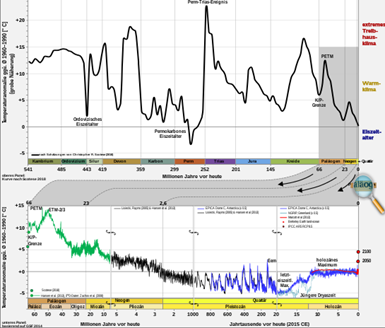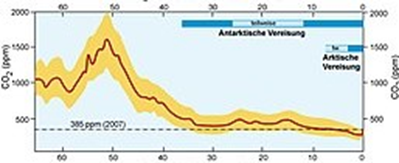MOJ
eISSN: 2574-9722


Mini Review Volume 8 Issue 2
Holistic Center, Switzerland
Correspondence: Doepp Manfred, Holistic Center, 13 Haupt St, Abtwil 9030, Switzerland
Received: April 03, 2023 | Published: April 18, 2023
Citation: Manfred D. Climate change: only climate gases or other factors as well? MOJ Biol Med. 2023;8(2):55-56. DOI: 10.15406/mojbm.2023.08.00184
Climate change has become a major contemporary issue. The goal of limiting the warming of the earth's atmosphere to 1.5 or at least 2.0 degrees Celcius is on everyone's lips. The entire global economy is being transformed on the basis of this effort. However, so far there is no proof that this goal will be achievable at all. Therefore, it is significant to consider whether there could be other factors besides CO2 that are warming the atmosphere. Here the technical radioactivity and the technical electrosmog are put up for discussion. Both could have significant climate-warming effects.
Keywords: anthropogenic, equilibrium, interglacials, greenhouse gases
Climate change out of general point of view is a globally occurring change in the climate on earth (or earth-like planets having an atmosphere). The cooling or warming associated with climate change can occur over varying periods of time. An important distinction is between those weather patterns that occur within the context of a climate state or zone, and climate change itself, which increases or decreases the probability of certain weather patterns occurring. The current, partly or mainly human-induced (anthropogenic) global warming is an example of a rapidly proceeding, but not yet completed climate change. The ecological and social crisis caused or predicted by current climate change is also referred to as a "climate crisis" or "climate catastrophe". Younger people in particular are reacting hysterically to the apparent trend toward a climate catastrophe. If they had lived at the time of the last little ice age - after the Middle Ages - they would be surprised about the general cold. Climate change on a global scale is essentially due to a variation in radiative forcing that shifts the earth's climate system from a stable thermal-radiative equilibrium to a new equilibrium. Radiative forcing results from atmospheric concentrations of greenhouse gases such as carbon dioxide (CO2), methane (CH4), and water vapor (H2O), from varying solar irradiance due to Milanković cycles, and from the reflectivity (albedo) of the Earth's surface, including the oceans. The climate state during the last millions of years was that of an ice age and was predominantly controlled by the Milanković cycles, which significantly altered solar radiation over tens of thousands of years, providing the impetus for the alternation of cold and warm periods.1 Taking the above factors into account, eleven of these warm periods (also called interglacials or interglacials) have been identified and described in detail during the last 800,000 years.2,3
Findings
It should be remembered that when a longer time period is considered, the current global warming is not unusual (Figure 1). In the course of 540 million years, the earth's temperature was predominantly higher than today. If, on the other hand, one takes the last 200 years, a certain warming can be recognized. However, this is mainly due.

Figure 1 The development of the earth temperature since 541 million of years.4
So, one should conclude that the current global warming is not unusual in any way. In general, people insist on the opinion that greenhouse gases - especially CO2 - are responsible for global warming, and that this is mainly of anthropogenic origin. However, if we look at the concentration of CO2 in the atmosphere over the last 64 million years (Figure 2), we can see that it was consistently higher in earlier times than it is today. Today's slight increase should again be interpreted as compensation for low values in the 16th/17th centuries the fact that we had a small ice age before, which is now compensated by our earth.

Figure 2 The concentration of Co2 in the earth atmosphere since 64 million of years.4
Causality
A central problem is that of causality. There is no doubt that the curves of earth temperature and CO2 have been running in parallel for several decades. However, to deduce a causal relationship from this correlation is unscientific. On the contrary, it can be a coincidence, as for example the decrease in the number of storks with a simultaneous decrease in the number of births does not prove that storks bring the babies.
However, if greenhouse gases may not be the decisive factor for the anthropogenic contribution to global warming, the question arises as to which other factors should be considered.
Further factors
To that end, let's look at what man-made changes have been made in recent decades that may have had an impact on the state of the atmosphere. We find radioactivity as the No. 1 topic. Many nuclear power plants have been and are being built around the world whose cooling water vapor contains tritium and deuterium. Nuclear weapons have been and are being produced, uranium-enriched munitions are used in wars. There is no safe repository for spent nuclear fuel rods in the world, they are mostly stored in the open. Thus, it can be stated that the warming of the atmosphere by man-made radionuclides is a factor that certainly plays a role. The radioactivity is called ionizing radiation. The ions produced in this way have a higher temperature than the original atoms in the air. Chernobyl and Fukushima also played a certain role.5 Then we find the technical electrosmog as factor No. 2. Compared to the almost idyllic state before the year 1990, we see a multiplication of the emission and transmission intensities by millions. While in former times one was pleased about a transmission performance of KiloByte/sec, today the providers advertise with GigaByte/sec. This radiation is considered to be non-ionizing, but at high intensities there is undoubted heating.6,7,8 Considering the future development with thousands of satellites as transmitters and receivers, with self-driving cars, with the «Internet of Things», with artificial intelligence «AI», with the robotized "Industry 4.0" etc one can predict that the thus caused global warming will continue to increase despite all efforts to reduce greenhouse gases. Additionally, other factors may be mentioned, such as the materials that are being used in the construction of large skyscrapers, and the overpopulation or concentration of inhabitants, are very small spaces, constituted by cities. Similarly, the indiscriminate felling carried out by some industrialists, in order to use wood as a raw material; mining that leads to the search for alternative materials for the manufacture of products such as batteries for mobile phones, in which they use products that harm the environment.
The two factors mentioned are not at all in the awareness of the population, they are rather unknown. The expected failure to reduce global warming through CO2 reduction, on the other hand, will lead to many people becoming desperate and possibly to riots. Even a CO2 tax or dictatorial restrictions on democratic freedoms will not change this. The least to be expected is that the technical application of radioactivity and/or the technical-caused electrosmog could be reduced. The insight to do so is missing up to now. Therefore, is this article to be regarded as the words of a caller in the wilderness?
None.
Authors declare that there is no conflict of interest.

©2023 Manfred. This is an open access article distributed under the terms of the, which permits unrestricted use, distribution, and build upon your work non-commercially.